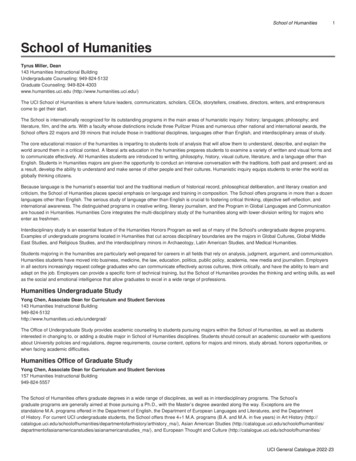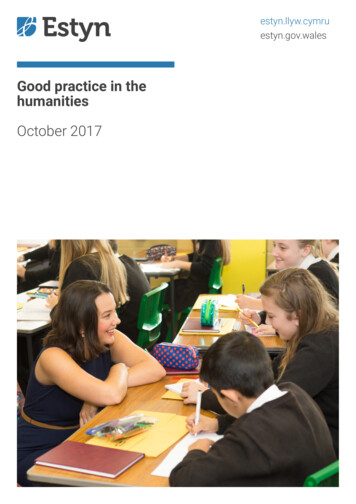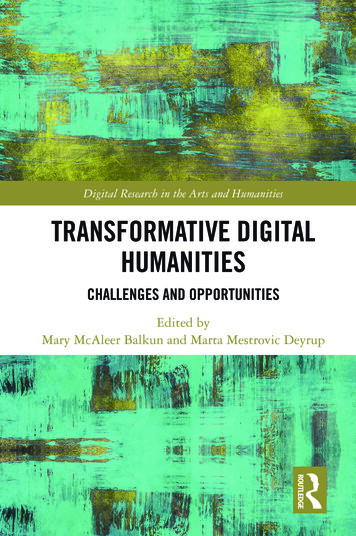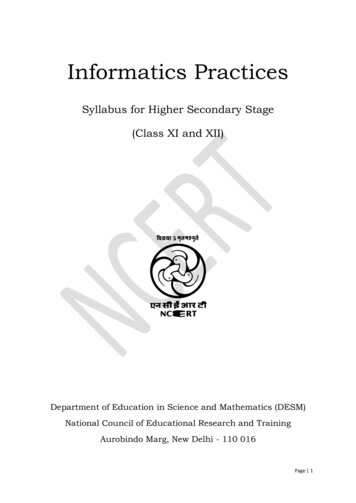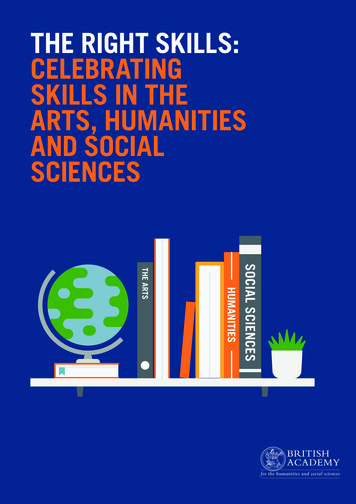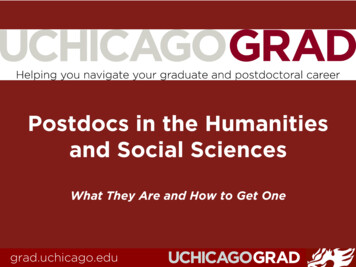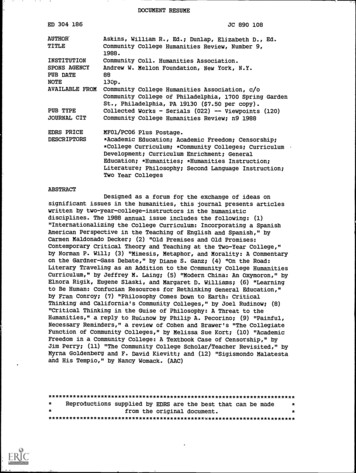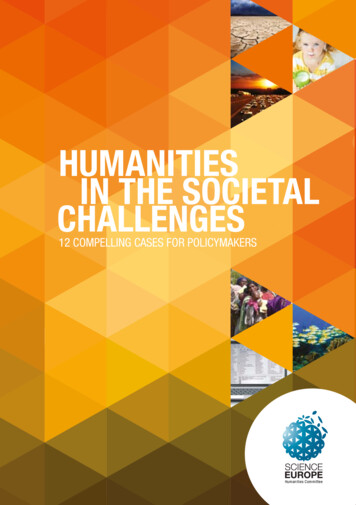
Transcription
Humanitiesin the SocietalChallenges12 compelling cases for policymakersHumanities Committee
About Science EuropeScience Europe is an association of major EuropeanResearch Funding and Research Performing Organisations,founded in October 2011 and with an office based inBrussels. It supports its Member Organisations in theirefforts to foster European research and to strengthen theEuropean Research Area.Further information: www.scienceeurope.orgAbout the Scientific Committeefor the HumanitiesScience Europe is informed and supported in its activities bysix Scientific Committees composed of highly-authoritativeacademics from all over Europe, representing the broadestrange of scientific communities and disciplines. TheCommittees act as the voice of researchers to ScienceEurope and are essential for the provision of scientificevidence to support science policy and strategy developmentsat pan-European and global level. The Scientific Committeefor the Humanities uses an inclusive understanding of thehumanities in which non-traditional humanities disciplines,such as digital humanities, education or performing arts anddesign, are also fully embedded.Further information: www.scienceeurope.org/humanitiesDate of Publication: September 2013
Table of ContentIntroduction5Challenge 1 Health, demographic change and wellbeing6Archaeologists, Biologists and Lactose ToleranceImproving Diagnoses through Examining Doctor-patient InteractionChallenge 2 European Bioeconomy Challenges10Learning from History to Shape Future Ocean PoliciesIntellectual Property and Global JusticeChallenge 3 Secure, clean and efficient energy14Let’s Give ‘Waste’ a Second LifeAddressing Climate Change with Renewable EnergyChallenge 4 Smart, green and integrated transport18Citizens as Co-designersDriving and DistractionsChallenge 5 Climate action, resource efficiency and raw materials24Environmental History of the Viennese DanubeClimate Change and Environmental MigrationsChallenge 7 Secure societies - Protecting freedom and security ofEurope and its citizensBalancing Individual Freedom and State ResponsibilityReligion and Society: Informing the Public Debate26
The Science Europe Scientific Committee for the Humanities, February 20134
IntroductionThe complex societal challenges that weare facing today cannot be explained byphysical, environmental and biologicalcauses alone; humans play a central role.Understanding the human factor isfundamental and can only be achievedby investigating the historical, cultural andcommunication processes in which humanlife is embedded. This is what the arts andhumanities have been studying for centuries,and this is why arts and humanities researchis an all-encompassing component inaddressing the societal challenges of thenew EU research and innovation frameworkprogramme, Horizon 2020.This brochure contains 12 compellingcase studies illustrating the impact ofarts and humanities-led research onall the challenges included in Horizon2020, beyond challenge six, ‘Europe ina changing world’. Together, the casesoffer full and rich evidence of the rangeof approaches and disciplines embracedby arts and humanities researchers; theydemonstrate the tangible impacts of keyresearch findings on real-world issuessuch as sustainable housing, energyconservation and inner-city crime;they also highlight how fundamentalarts and humanities research leads toinnovation that can rarely be foreseen.For example, methodologies derivedfrom linguistics have helped to createa cost-effective instrument to improvethe diagnosis of patients with epilepticseizures. Similarly, re-thinking ‘waste’as a resource, rather than junk, istransforming how the constructionindustry approaches waste disposal,hereby significantly reducing the amountof waste.The development of Horizon 2020 isat a critical stage, where the promisesof an integrative research approach toall the grand challenges can see theirrealisation and implementation. The aimof this brochure is to help advance thisapproach by documenting how arts andhumanities-led research already thrivesacross all societal challenges. TheScience Europe Scientific Committee forthe Humanities hopes that these casestudies will provide a source of inspiration toscope future research in terms of researchquestions, organisational frameworks,methodologies, research outcomes andtheir wider impact on society.Professor Kirsten Drotner,Chair, Scientific Committee for the Humanities, Science Europe5
Archaeologists,Biologists andLactose ToleranceWhy are People in the North of EuropeMore Tolerant of Lactose?Most people in Northern European countries, such as Finland and Sweden, are tolerant oflactose. This is interesting, since 65% or more of the total human population is actuallylactose intolerant. If it was understood why so many people in the north of Europe arenot affected by this problem, the quality of life for millions of people could potentially beimproved.Northern European May not Always Have Been‘Heavy Milk Drinkers’The high frequency of lactose tolerance inNorthern Europe has traditionally beenexplained in genetic terms, suggesting thathigh lactose tolerance in these areas is theresult of the importance given to dairyproducts in the inhabitants’ dietary habits.This view also assumes that fresh milkconsumption has always been commonin these areas. Recently, an innovative,interdisciplinary collaboration of Finnishbiologists and archaeologists decided toinvestigate these issues. Their findingsshow that none of the traditional beliefs arelikely to be true.6The study provides several pieces ofarchaeological and historical evidence thatsuggest that cattle herding was neitherwidespread nor productive enough inNorthern Europe to provide a constantaccess to fresh milk. Instead, the studyprovides the alternative explanation thatthe high tolerance to lactose in northernEuropeans could be due to immigration.In particular, it could be explained by themigration movements of people from theso-called ‘Corded Ware Culture’, an earlyculture from Central Europe.
C h a l l e n g e 1 Health, demographic change and wellbeingLactose tolerancecould be explainedby migrationRe-thinkingthe Way we Deal withFood IntoleranceEastern Finncattle animals, representatives of an old local cattle breed, grazing in thehistorical landscape of Koli, eastern Finland Heimo Tynkkynen, MTT AgrifoodResearch Finland ArchiveThis research is of practical interest tomedical doctors and health practitionersbecause it disconfirms the traditionalassumption that some people arelactose tolerant because they are usedto consuming dairy products. Theresults of the study prompt medicalresearchers to start looking into otherhypotheses. The project also haspotential to impact the direction offuture research, as a promisingexample of how biologists andarchaeologists can complement eachother. The study shows the successof this original collaboration and theimportance of the new perspective itoffers. In this way, the study paves theway for further, larger-scale work ofthis type. Publication: High Lactose Tolerance in North Europeans: A Result of Migration, Not In Situ Milk Consumption,Perspectives in Biology and Medicine, Volume 55, Number 2, 2012 Authors: Dr Timo Vuorisalo, Dr Olli Arjamaa, Dr Anti Vasemägi, Professor Jussi-Pekka Taavitsainen, Dr Auli Tourunen, andDr Irma Saloniemi, University of Turku, Finland Timeline: 2012 Further Information: muse.jhu.edu/login?auth 0&type summary&url /journals/perspectives in biology and medicine/v055/55.2.vuorisalo.html7
Improving Diagnosesthrough ExaminingDoctor-patient InteractionDistinguishing Epileptic Seizures fromThere are various conditions that may causeblackouts in patients. Two of the mostcommon conditions are epileptic seizuresand psychogenic non-epileptic seizures.Despite advances in medical tests, cliniciansoften struggle to distinguish between thesetwo types of seizure. However, a correctdiagnosis is all-important before choosingtreatment. At present, over three-quarters ofpatients with non-epileptic seizures initiallyreceive ineffective, and potentiallyNon-epileptic Seizuresdangerous, treatment with antiepilepticdrugs. One reason for the high rate ofmisdiagnosis is that traditionally doctors havefocussed more on what patients say than howthey speak. This series of multidisciplinarystudies did things differently; involving linguists,neurologists, psychologists and sociologistsin several European countries, this researchexplored whether the examination ofdoctor-patient interaction can help in thediagnostic process.How Patients Speak,Focussing onRather Than on What They SayUsing a method derived from ‘ConversationAnalysis’ – an approach to the study ofsocial interaction that embraces bothverbal and non-verbal conduct in situationsof everyday life – this project examined morethan 150 interactions between doctors andpatients in which seizures were discussed.A set of linguistically-describable featureswere identified, which appeared to havediscriminating value. For example, it wasfound that epileptic patients tend to focuson the symptoms of the seizure, while8patients suffering from non-epilepticseizures more often focus on the situationsin which seizures have occurred (see thetable for further key findings). The projectshowed that this approach can helpclinicians to differentiate betweenepileptic and non-epileptic patients. Indeed,patients’ communication profiles allowedlinguists – who lacked any other medicalinformation related to the patients – tocorrectly predict 85% of medical diagnosis onthe basis of video-electrographic recordings.
C h a l l e n g e 1 Health, demographic change and wellbeingConversational featureEpilepsyNonepileptic SeizuresInteractionalPatients talk about seizuresymptoms without promptingand have no difficulty focusingon specific seizure episodes.Patients avoid talking aboutseizure symptoms and havedifficulty focusing on specificseizure episodes.TopicalPatients focus on seizuresymptoms.Patients focus on the situationsin which seizures have occurredand their consequences.LinguisticPatients go to great length andtrouble in formulating accountsof their seizure experiences.Metaphors: seizures aredescribed as external andhostile independent agents.Patients provide a minimaldescription of seizuresymptoms. Metaphors: seizuresare described as a spacethrough which the patientpasses.Conversational features help to differentiate between epileptic and non-epileptic seizuresFrom Seizure Patients to Patients withAnxiety Disorders and Memory ProblemsThanks to the successful application ofConversation Analysis in seizure clinics, morepatients will be given appropriate treatment.Building on this work, the method has alsobeen applied successfully in the differentialdiagnosis of anxiety disorders. Furtherresearch is underway to find out whether thismethod can also be applied to treat patientswith other pathologies, such as memoryproblems. The deeper understanding ofpatients’ narratives has proven to be apowerful and cost-effective instrument toreduce the number of diagnostic errors andto improve the quality of patient care. Project Title: ‘Using linguistic methodologies to improve diagnoses in patients with seizures’ Project Leaders: In Germany: Professor Elisabeth Gülich, Bielefeld University, and Dr med. Martin Schöndienst,Ev. Krankenhaus Mara Klinik f. Neurologie und Epilepsie, Bielefeld. In UK: Professor Markus Reuber, University of Sheffield,and Professor Paul Drew, Loughborough University Timeline: In Germany as from 1999 and in the UK as from 2006 Further Information: rch-grants-programme/200 7-2008/markus-reuberand ng/9
Learning fromHistory to ShapeFuture Ocean PoliciesWhat do Studies of Past Ocean LifeThe oceans offer a rich resource forfeeding a hungry world, and a keychallenge is to preserve the oceans in asustainable and long-term manner. Theglobal research network ‘History of MarineAnimals Populations’ starts from a simple,Teach Us?yet fundamental, question: how mightstudies of past ocean life and of humaninteraction with the sea inform futurepolicies for managing, restoring andconserving marine and coastalecosystems?Humans Impact the Ocean Ecology Alreadyfor Over 2000 YearsBringing together over a hundred historians,archaeologists, paleoecologists,oceanographers and marine scientists,the network identifies when, how and whyhumans have impacted life in the oceans.Based on historical and environmentalarchives, the network has demonstratedthe significance of fishing between 2000and 500 years ago. Their studies cover 15regions of the world, with a focus on majorspecies such as cod, herring, salmon andtuna. For example, the researchers havedemonstrated that Classical Rome had ahuge fishing industry, extracting more than100,000 tonnes each year from theMediterranean. This is a complete10revelation to historians who havetraditionally claimed that fishing wasinsignificant in those times, with noecological impact. Another example is thediscovery that herring fisheries in the NorthSea had already reached today’srecommended Total Allowable Catch by1880. In other words, human impacts onocean ecology are of much greaterhistorical significance than previouslythought. The consequences are not onlythat some major species were fished tocommercial extinction before 1914, but alsothat globalising effects on the industry andmarket have a long history.
C h a l l e n g e 2 European Bioeconomy ChallengesHerring fisheriesin the North Seahad alreadyreached today’srecommendedTotal AllowableCatch by 1880Oyster industry at Hampton, Virginia (US), circa 1913 Census of Marine Life E&OInfluencing Marine Policy Regulation,Preservation and ManagementThe research findings provide baselines ofspecies abundance and distribution prior tomodern fisheries. Such knowledge helps usunderstand the role of the sea for pastsocieties and to predict future oceanresilience. In 2010, the network helpedpublish the first comprehensive Censusof Marine Life in 25 key ocean areas,documenting a marine environment richer indiversity, more connected through speciesdistribution and movement, and moreimpacted by humans than has beenassumed. The International Council for theExploration of the Sea has recognised therelevance of this research by establishing aWorking Group on History of Fish andFisheries. Fisheries agencies around theworld now use historical evidence formanagement advice. As part of anemerging field of marine environmentalhistory, the network is likely to impact policyregulation, preservation and managementin the future by further advancing andsolidifying time-based knowledge on thecontinuities and changes in marine andcoastal ecosystems. Project Title: ‘History of Marine Animal Populations’ Chair of the Network’s Steering Committee: Professor Poul Holm, Trinity College Dublin, Ireland Timeline: 2000-2010 (first stage); 2011-2020 (second stage) Further Information: www.hmapcoml.org11
Intellectual Propertyand Global JusticeReducing the Gapbetween Rich and PoorThe TRIPS agreement (Trade-Relatedaspects of Intellectual Property rights) setsworldwide minimum standards for theprotection of intellectual property rights,including patents, copyright, and breeders’rights. Originally introduced to stimulateinnovation, nowadays this agreement canoften have the reverse effect and candiscourage innovation. For example,registering a certain genome sequence ingenetically modified crops can block furtherresearch into that crop or hinder applicationsby poor countries and institutions. Thisproject aims to find out how IntellectualProperty rights can be implemented in away that will minimise such drawbacks.The study combines ethical, philosophicaland social research, and is conductedin close co-operation with life scienceresearch institutes.12Alternatives to PromoteAgriculturalInnovationCurrently, various pioneering initiativesare being developed that offer alternativeways to protect Individual Property rights,which may be less prone to misuse.These initiatives either build upon currentregulations or improve and replace these.One example is the creation of ‘commonknowledge pools’ where knowledge isshared freely among members (that is,among the participating inventors).Another is the introduction of ‘opensource price systems’, where inventorsare paid a fee for their invention upfrontand refrain from further royalties. A finalexample is ‘humanitarian licenses’:provisions in a license whereby inventorsprotect in advance the possibility of sharingtheir technology with people in need.The project investigated these initiativesand found that they can, in fact, promoteagricultural innovation for poor countries,rather than hampering them. The findingssuggest that these initiatives offerinteresting alternatives; however, thereis no ‘one size fits all’ solution, and it isimportant to pay attention to the diversityand complexity of different cases.
C h a l l e n g e 2 European Bioeconomy ChallengesOriginally introduced tostimulate innovation,nowadays the TRIPSagreement can have thereverse effect and candiscourage innovationMany developments in biotechnologyhave become patentable during recentyears. An example is the patenting ofscientifically developed crops ShutterstockTowards a Change in the CurrentIntellectual Property SystemAn increasing number of stakeholders are convinced about the necessity of changingthe current intellectual property system and restricting patenting. For example, theproject has advised the European Patent Office and the Dutch and Germangovernments on policy measures that aim to expand breeders’ exemptions, and tocreate a common pool across the EU countries. Overall, the project has encouragedstakeholders to look critically at a straightforward implementation of the TRIPSagreement worldwide. A change may be required in order to adapt to social, ecologicaland agricultural needs. Project Title: ‘Blocked innovations? Intellectual Property and Global Justice’ Project Leader: Professor Michiel Korthals, Wageningen University and Centre for Society and the Life Sciences, RadboudUniversity Nijmegen, the Netherlands Timeline: 2009-2014 Further Information: project/artikel/ip-and-global-justice.html13
Let’s Give ‘Waste’a Second LifeWasteProductionReduce theThe EU produces three billion tonnesof waste each year, almost one third ofwhich derives from construction. Thismeans that in the UK, for example, forevery four houses built, the materialequivalent of one house is thrown away.To address this issue, internationaltargets have been developed by ‘OnePlanet Living’, a global initiative based onten principles of sustainability developedby BioRegional and the World WideFund for Nature (WWF). Brighton in theUK is the first city in the world to haveembraced the ‘One Planet’ approach,launching a ‘One Planet Action Plan’ inMay 2013. One of the specific targetsset out in the Brighton plan is to reach85% recycling rate on internal operationswithin three years.The Waste Houseexperiment in Brighton responds to thischallenge. In this project, researchers andstudents from the design and constructionsectors are working with architects todesign and build the UK’s first eco-housemade from waste and surplus materials.14A House Builtfrom WasteThe project investigates strategies forconstructing a contemporary, lowenergy, permanent domestic buildingusing over 85% ‘waste’ material drawnfrom household and construction sites.It also investigates strategies to effectively‘lock in’ toxic, oil-based waste(predominantly plastic) into the builtfabric of towns and cities. An elementof the research includes local communityengagement in the co-production ofsolutions that will positively influencefuture environmental behaviours. In thewords of the project leader, ArchitectDuncan Baker-Brown, this project isproving that “There is no such thing aswaste, just stuff in the wrong place”.
C h a l l e n g e 3 Secure, clean and efficient energyThe Brighton Waste House, 50% complete Duncan Baker-Brown, University of Brighton“There is no such thing as waste,just stuff in the wrong place”,Project Leader Duncan Baker-BrownTransforming How the Construction IndustryApproaches Waste DisposalThis research is examining ways in which‘waste’ material may be a reconceived as auseable resource. This is an innovative wayof thinking that, by adding value to waste,has important practical implications: it has thepotential to transform how the constructionindustry approaches waste disposal.Significant challenges are to see if theproject offers a scalable solution for massproduction, as well as what the policy,environmental, social and cultural issuesof this new approach to the creation ofbuildings from waste might be. The projecthas already captured public imaginationthrough extensive media coverage andhas drawn the interest of politicians,policymakers, industry and civic authoritiesin the UK. Project Title: ‘The Waste House’ Project Leader: Duncan Baker-Brown, University of Brighton, UK Timeline: Completion in December 2013 Further Information: the-house-that-kevin-built15
Addressing ClimateChange withRenewable EnergyNuclear-generated Electricity isIs Atomic Energy the MostCost-effectiveSolution?The nuclear industry has claimed that inorder to address climate change, atomicenergy is the most cost-effective power.However, the UK SustainableDevelopment Commission stated in2006 that ‘‘Cost estimates from the[nuclear] industry have been subject tomassive underestimates — inaccuracyof an astonishing kind consistently over a40-50-year period’’.1 Such chargessuggest the need to scrutinise the claimsin the light of scientific evidence. Thecurrent investigations analyse theseclaims, combining expertise from thefields of environmental ethics, philosophyof science, economics and physics.1 Porritt, J., Chair of the UK Sustainable Development Commission.(2006). Quoted in House of Commons Trade and Industry Committee, New nuclear? Examining the issues, Fourth Report of Session2005–2006, Vol. 1. London: House of Commons.16More Expensivethan Often ThoughtSurveying 30 recent nuclear analyses, theinvestigations show that industry-fundedstudies appear to be subject to conflictsof interest and to illegitimately trim costdata. For example, they underestimateinterest rates, overestimate reactorlifetimes and exclude costs of full-liabilityinsurance. If these trimmed costs areincluded, nuclear-generated electricitycan be shown to be roughly six timesmore expensive than most studies claim.Further research shows that, once onecounts all the costs, energy efficiencyand renewable solutions – like wind orsolar energy – are in fact more effective.In the end, the cheapest, lowest-carbon,most-sustainable energy solutions alsohappen to be the most ethical. Theinvestigations therefore conclude thatalthough there may be reasons to usereactors to address climate change,economics does not appear to be oneof them.
C h a l l e n g e 3 Secure, clean and efficient energyWind energy: an ethical energy solution that turns out to be cost-effective ShutterstockThe cheapest, lowest-carbon, mostsustainable energy solutionsalso happen to be the most ethicalFeeding theClimate Change DebateGiven these important results,governments in the US, Australia,Canada, the Netherlands, and Norwayhave asked for the advice of the projectleader on science and energy policies.This evidence-based research is assistingorganisations such as the USEnvironmental Protection Agency, the USDepartment of Energy, the InternationalCommission on Radiological Protection,and the World Health Organisation inshaping their environmental and energypolicies. Publications: Climate Change, Nuclear Economics, and Conflicts of Interest, Science and Engineering Ethics, 17:75-107,2009. What Will Work: Addressing Climate Change with Renewable Energy, Not Nuclear Power, New York: Oxford UniversityPress, 2011 Author: Professor Kristin Shrader-Frechette, University of Notre Dame, US Timeline: 2009-2011 Further Information: www3.nd.edu/ kshrader/pubs/17
Citizens asCo-designersCan the NewMethodology ofCo-design DeliverWhat it Promises?The co-design methodology is a newdevelopment that aims to engage endusers – citizens, residents, consumers,customers – in the design process, inorder to increase their acceptance of,and satisfaction with, the final product.The overall objective is to use design asa driver for innovation, economic growthand sustainable development.Through aseries of pilot actions, the PROUD projectinvestigates the question of whetherco-design processes can deliver what theypromise: to increase people’s engagementand create more sustainable andsuccessful products, services andenvironments. If so, how couldorganisations in the public and privatesectors see the benefits of co-designing,and understand the role that designerscan play? And how can designers betrained to adequately play their role inco-design processes?18RegionalSocial IssuesSolutions forThe project has initiated five pilot actions.One of these is taking place in the Brieregion near Paris, where a co-designmethodology is being used to bringtogether stakeholders and to find aninnovative solution in terms of housingand activities to prolong the touristseason. Another pilot concerns the designof the Castle Park in Lancaster, UK; thisis a project involving the local authoritiesand residents which has increased thenumber of people involved in theprocess, intensified their participation,stimulated their creativity and broughtabout hundreds of ideas that are nowbeing explored for possible realisation.Overall, it was found that thedesigners, businesses and publicauthorities involved in PROUD pilotactions no longer chose standardsolutions but, when presented withalternatives, preferred working in a moreuser-oriented way.
C h a l l e n g e 4 Smart, green and integrated transportThe pilotactions report thatthe co-designmethodology canbring about costreduction andincreased customersatisfactionRailway station NS Beukenlaan, Eindhoven during Dutch Design Week 2012:one of the PROUD actions to pilot co-design methods while improving the users‘experience of the station and its areas Vincent WittenbergStimulate InnovationCo-design canin Organisations and BusinessesThe first results of the PROUD projectsuggest that the project s methodologycan improve public services and stimulateinnovation in organisations and businesses.The pilot actions report that the co-designmethodology can bring about costreduction, better services, moreownership by citizens, and increasedcustomer satisfaction. The designers andother creative professionals who havetaken part in the project, and who havebeen trained in working on co-designprocesses, enlarged the scope of theirbusinesses and created new businessopportunities. This is promising firstevidence that the co-design approach maylead to improved deliveries by businesses,and may increase their competitive edge. Project Title: ‘PROUD – People Researchers Organisations Using Design for innovation and co-creation’ Lead Partner: Capital D, Design Cooperation Brainport, Eindhoven, the Netherlands Timeline: 2011-2014 Further Information: www.proudeurope.eu19
Driving andDistractionsExamining RealPeople, in RealTime, in Their Own CarDistractions frequently occur whilstpeople are driving, and these are knownto contribute to road accidents.Previous research has identified manyforms of distraction – such as mobilephones, eating and drinking, orconversation with passengers – andhas considered their impact on drivingactivities. Nevertheless, relatively littleis yet known about how distractionsemerge, are managed and are solved inreal-world driving situations, despite thedanger that these situations represent.This study, carried out by an Australianand Finnish partnership, built on previousresearch by examining real people, inreal time, in their everyday car journeysto find out: how do people, in real-life,perform multiple tasks simultaneously?Precisely what do they do? How do incar distractions occur, and how do theyimpact on driving activities?20Different Types ofDistractionResearch in this area typically draws ondata collected from questionnaires orfrom experimental driving simulators.A particular strength of this study is itsinnovative, alternative approach, whichrelies on video-recorded data collected inreal driving situations. This new approachis grounded in the combined expertisefrom a variety of humanities fields:conversation analysis and ethnomethodology, as well as gesturestudies and multimodal interactionanalysis. The study found that differentkinds of distraction impact driving inquite different ways – not necessarily allnegatively. Some distractions are routineand predictable, and occur under thedriver’s control, such as grooming andeating activities, or making an outgoingphone call. Other distractions can behighly unpredictable, like participation inconversation (especially with children) orreacting to a ringing mobile phone. Whilethe latter activities can seriously impairdriving and potentially contribute toaccidents, the former represents regularpractice, which is less likely to do so.
C h a l l e n g e 4 Smart, green and integrated transportMobile phones and map reading: two typical multitasking driver distractions Road Safety Grant Report 2010–001, In-car distractions and theirimpact on driving activities, Australian National University 2010The study found that different kinds ofdistraction impact driving in quite different ways –not necessarily all negativelyBenefits forRoad SafetyThis research has strong potential to improveroad safety by informing and improvingdriver training programmes and publicguidance campaigns. Fo
InTROduCTIOn The complex societal challenges that we are facing today cannot be explained by physical, environmental and biological causes alone; humans play a central role.


